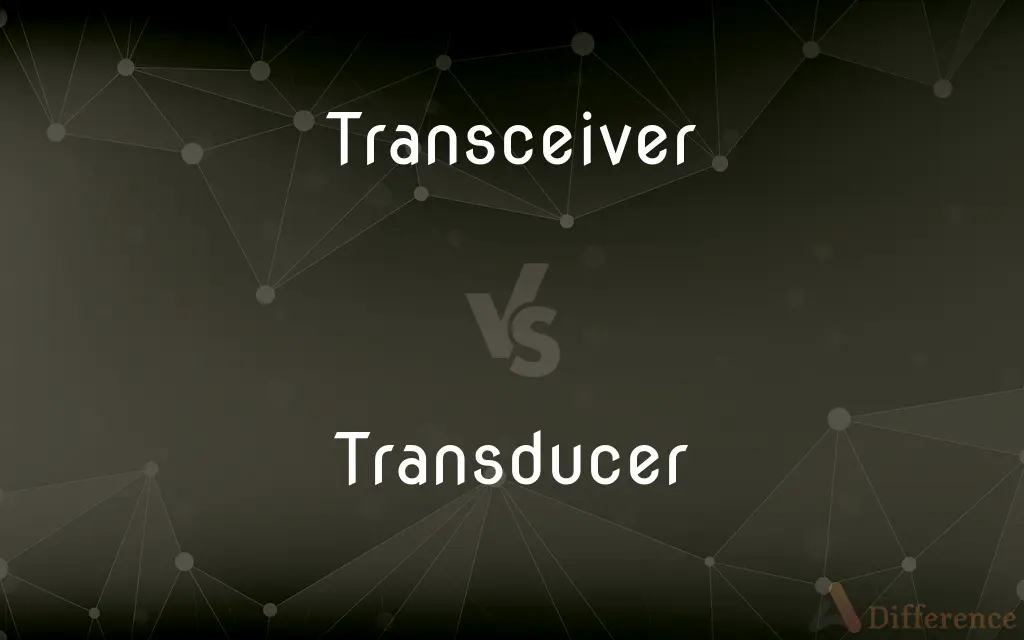Transceiver vs. Transducer — What's the Difference?
By Tayyaba Rehman & Maham Liaqat — Updated on March 7, 2024
Transceivers combine transmitter and receiver functionalities into one unit for communication, while transducers convert one form of energy into another.

Difference Between Transceiver and Transducer
Table of Contents
ADVERTISEMENT
Key Differences
Transceivers are integral to communication systems, combining the capabilities of both transmitting and receiving signals within a single device. This dual functionality facilitates two-way communication in various applications, from radios to network interfaces. On the other hand, transducers are devices that convert energy from one form to another, such as sound waves to electrical signals or vice versa, playing crucial roles in sensors, microphones, and speakers.
While transceivers focus on the exchange of electromagnetic signals for communication purposes, transducers deal with a broader range of energy forms. For example, a thermocouple converts thermal energy into electrical signals, highlighting the transducer's versatility beyond communication technologies. Transceivers, however, are specifically designed to send and receive coded messages, such as data packets over a network or voice communications over airwaves.
The design complexities of transceivers often include modulation and demodulation components, antennas, and digital processing units to handle the bidirectional flow of data. In contrast, transducers might consist of simpler components like a diaphragm and coil in a microphone, which captures sound and converts it into an electrical signal without the need for complex processing or signal encoding.
Transceivers are foundational in creating interconnected networks and communication systems, including wireless, fiber-optic, and Ethernet connections. Conversely, transducers are ubiquitous in converting physical quantities into measurable signals, essential in medical devices, automotive sensors, and environmental monitoring instruments.
The innovation in transceiver technology leans towards increasing data transmission rates and enhancing signal clarity across vast distances, aiming to support the growing demands of telecommunications and internet services. Meanwhile, advancements in transducer technology focus on improving sensitivity, accuracy, and energy efficiency, which are vital for precision instrumentation and energy-harvesting applications.
ADVERTISEMENT
Comparison Chart
Functionality
Transmits and receives electromagnetic signals
Converts one form of energy into another
Primary Use
Communication (e.g., radios, network devices)
Sensing and actuation (e.g., microphones, sensors)
Key Components
Antennas, modulators, demodulators
Diaphragms, coils, piezoelectric elements
Complexity
Complex, with digital processing units
Can be simple or complex, depending on the application
Applications
Wireless communication, networking
Measurement, medical devices, audio devices
Technological Focus
Enhancing data rates, signal clarity
Improving sensitivity, accuracy, energy efficiency
Energy Interaction
Primarily electromagnetic signals
Various forms, including mechanical, thermal, electrical
Example Devices
Wi-Fi routers, cell phones
Thermocouples, accelerometers
Compare with Definitions
Transceiver
A device that can both transmit and receive communications, as in a wireless router.
The wireless transceiver enabled the computer to connect to the internet without cables.
Transducer
Essential for environmental monitoring instruments, detecting changes in physical conditions.
The humidity transducer measures moisture levels in the air for climate control systems.
Transceiver
Integral to network interfaces, allowing devices to send and receive data over networks.
The Ethernet transceiver connects the computer to the local area network.
Transducer
Used in sensors to measure physical properties, such as temperature or pressure.
The pressure transducer converted the water pressure into a readable electrical signal.
Transceiver
Used in various communication technologies, integrating both sending and receiving capabilities.
The satellite transceiver communicates with the ground station and other satellites.
Transducer
Involved in audio devices to convert electrical signals into sound.
The speaker's transducer converted the electrical signals into audible sound waves.
Transceiver
Facilitates global connectivity through technologies like cellular networks.
Mobile phones contain transceivers to make calls and access the internet.
Transducer
A device that converts one form of energy into another, like a microphone converting sound into electrical signals.
The transducer in the microphone captured the singer's voice as electrical signals.
Transceiver
Essential for two-way radio communications, such as walkie-talkies.
Emergency services use transceivers for reliable communication in critical situations.
Transducer
Key component in medical devices, like ultrasound machines.
The ultrasound transducer emits sound waves and receives the echoes to create images.
Transceiver
In radio communication, a transceiver is an electronic device which is a combination of a radio transmitter and a receiver, hence the name. It can both transmit and receive radio waves using an antenna, for communication purposes.
Transducer
A transducer is a device that converts energy from one form to another. Usually a transducer converts a signal in one form of energy to a signal in another.Transducers are often employed at the boundaries of automation, measurement, and control systems, where electrical signals are converted to and from other physical quantities (energy, force, torque, light, motion, position, etc.).
Transceiver
A transmitter and receiver housed together in a single unit and having some circuits in common, often for portable or mobile use.
Transducer
(Physics) A substance or device, such as a piezoelectric crystal, microphone, or photoelectric cell, that converts input energy of one form into output energy of another.
Transceiver
A combined radio transmitter and receiver.
Transducer
(Biology) Something, such as a receptor in a cell membrane, that transmits a signal within a cell or from the exterior of a cell to its interior.
Transceiver
(computing) A device that performs transmitting and receiving functions, especially if using common components.
Transducer
A device that converts energy from one form into another.
Transducer
(computing theory) A state machine that generates output based on a given input.
Transducer
An electrical device that converts one form of energy into another
Common Curiosities
Can transceivers be used in mobile phones?
Yes, mobile phones use transceivers to facilitate wireless communication by sending and receiving signals.
What makes a transceiver different from a transmitter?
A transceiver combines the functionalities of both a transmitter and a receiver in one unit, whereas a transmitter only sends signals.
What is the main function of a transceiver?
A transceiver's main function is to transmit and receive electromagnetic signals for communication purposes.
Are transducers used in everyday devices?
Yes, transducers are used in many everyday devices, including microphones, speakers, and various sensors.
Can transceivers be used for satellite communication?
Yes, transceivers are used in satellite communication systems to send and receive signals to and from satellites.
What is the difference in complexity between transceivers and transducers?
Transceivers tend to be more complex due to the need for signal processing and integration of transmission and reception, while transducers can range from simple to complex based on their specific function.
How important are transceivers in networking?
Transceivers are crucial in networking, enabling devices to communicate over wired or wireless networks by handling data transmission and reception.
Is Wi-Fi a type of transceiver?
Wi-Fi technology involves the use of wireless transceivers to send and receive data over radio frequencies.
How does a transducer work?
A transducer works by converting one form of energy into another, such as mechanical energy into electrical signals.
What role do transducers play in healthcare?
Transducers play a vital role in healthcare, particularly in diagnostic devices like ultrasound machines, where they convert energy forms to create images or measure physiological parameters.
Can transducers generate power?
Some transducers can generate power, such as piezoelectric elements that convert mechanical stress into electrical energy.
Do transducers only convert energy into electrical signals?
While many transducers convert energy into electrical signals, they can also work in reverse or convert into other energy forms.
Are all transducers electronic devices?
While many transducers are electronic, converting energy to and from electrical signals, the term broadly encompasses any device that converts between different forms of energy.
How do transducers affect sensor technology?
Transducers are fundamental to sensor technology, enabling the conversion of physical quantities into signals that can be measured and analyzed.
Can transceivers and transducers be used together?
Yes, in complex systems, transceivers and transducers can be used together, with transducers sensing or actuating physical changes and transceivers facilitating communication of the relevant data.
Share Your Discovery

Previous Comparison
Jingle vs. Yell
Next Comparison
Mislabeled vs. MislabelledAuthor Spotlight
Written by
Tayyaba RehmanTayyaba Rehman is a distinguished writer, currently serving as a primary contributor to askdifference.com. As a researcher in semantics and etymology, Tayyaba's passion for the complexity of languages and their distinctions has found a perfect home on the platform. Tayyaba delves into the intricacies of language, distinguishing between commonly confused words and phrases, thereby providing clarity for readers worldwide.
Co-written by
Maham Liaqat















































